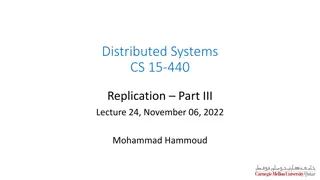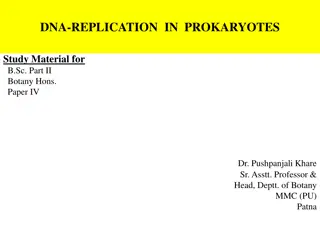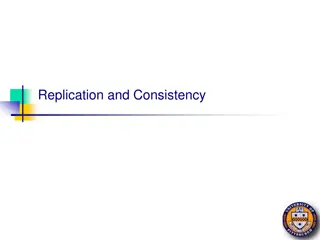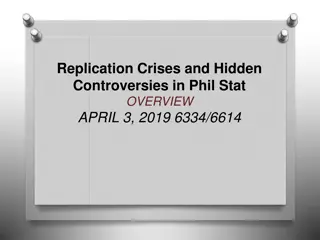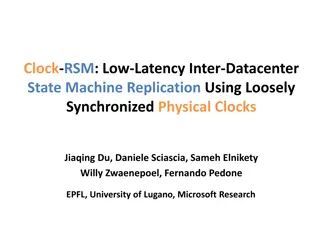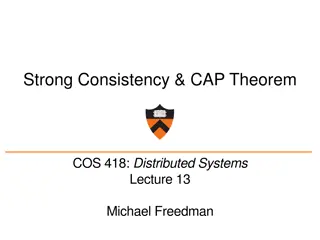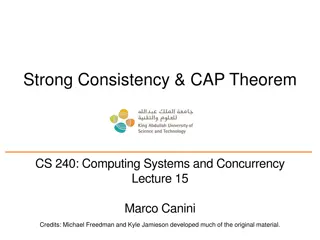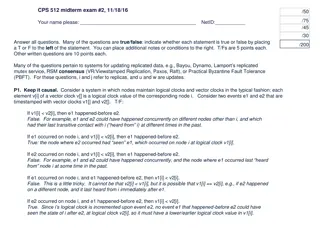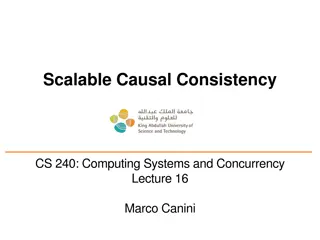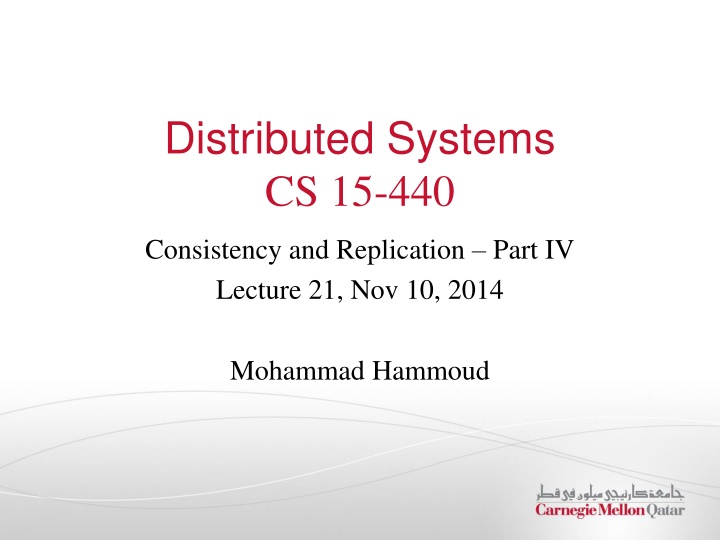
Consistency Models and Replica Management in Distributed Systems
Explore different consistency models in distributed systems, including data-centric and client-centric approaches. Learn about replica management, server placement, and consistency protocols for ensuring data integrity and availability in distributed environments.
Download Presentation

Please find below an Image/Link to download the presentation.
The content on the website is provided AS IS for your information and personal use only. It may not be sold, licensed, or shared on other websites without obtaining consent from the author. If you encounter any issues during the download, it is possible that the publisher has removed the file from their server.
You are allowed to download the files provided on this website for personal or commercial use, subject to the condition that they are used lawfully. All files are the property of their respective owners.
The content on the website is provided AS IS for your information and personal use only. It may not be sold, licensed, or shared on other websites without obtaining consent from the author.
E N D
Presentation Transcript
Distributed Systems CS 15-440 Consistency and Replication Part IV Lecture 21, Nov 10, 2014 Mohammad Hammoud
Today Last Session Consistency and Replication Part III Client-Centric Consistency Models Today s Session Consistency and Replication Part IV Replica Management & Consistency Protocols Announcements: P3 is due on Wednesday Nov 12 by midnight PS4 is due on Saturday Nov 15 by midnight 2
Overview Consistency Models Data-centric Consistency Models Client-centric Consistency Models Replica Management Replica Server Placement Content Replication and Placement Consistency Protocols Primary-based protocols Replicated-write protocols Cache-coherence protocols 3
Summary of Consistency Models Different applications require different levels of consistency Data-centric consistency models Define how replicas in a data-store maintain consistency across a collection of concurrent processes Client-centric consistency models Provide an efficient, but weaker form of consistency One client process updates the data item, and many processes read the replica Define how replicas in a data-store maintain consistency for a single process 4
Overview Consistency Models Data-centric Consistency Models Client-centric Consistency Models Replica Management Replica Server Placement Content Replication and Placement Consistency Protocols Primary-based protocols Replicated-write protocols Cache-coherence protocols 5
Replica Management Replica management describes where, when and by whom replicas should be placed We will study two problems under replica management 1. Replica-Server Placement Decides the best locations to place the replica server that can host data-stores 2. Content Replication and Placement Finds the best server for placing the contents 6
Overview Consistency Models Data-centric Consistency Models Client-centric Consistency Models Replica Management Replica Server Placement Content Replication and Placement Consistency Protocols Primary-based protocols Replicated-write protocols Cache-coherence protocols 7
Replica Server Placement Factors that affect placement of replica servers: What are the possible locations where servers can be placed? Should we place replica servers close-by or distribute them uniformly? How many replica servers can be placed? What are the trade-offs between placing many replica servers vs. few? How many clients are accessing the data from a location? More replicas at locations where most clients access improves performance and fault-tolerance If K replicas have to be placed out of N possible locations, find the best K out of N locations(K<N) 8
Replica Server Placement An Example Approach Problem: K replica servers should be placed on some of the N possible replica sites such that Clients have low-latency/high-bandwidth connections Qiu et al. [2] suggested a Greedy Approach C=100 1. Evaluate the cost of placing a replica on each of the N potential sites Examining the cost of C clients connecting to the replica Cost of a link can be 1/bandwidth or latency Choose the lowest-cost site In the second iteration, search for a second replica site which, in conjunction with the already selected site, yields the lowest cost Iterate steps 2,3 and 4 until K replicas are chosen R1 C=40 2. 3. R2 R2 C=90 R4 C=60 R3 R3 4. 9
Overview Consistency Models Data-centric Consistency Models Client-centric Consistency Models Replica Management Replica Server Placement Content Replication and Placement Consistency Protocols Primary-based protocols Replicated-write protocols Cache-coherence protocols 10
Content Replication and Placement In addition to the server placement, it is important to know: how, when and by whom different data items (contents) are placed on possible replica servers Identify how webpage replicas are replicated: Primary Servers in an organization Replica Servers on external hosting sites Permanent Replicas Server-initiated Replicas Client-initiated Replicas 11
Logical Organization of Replicas Permanent Replicas Server-Initiated Replicas Client-initiated Replicas Clients Server-initiated Replication Client-initiated Replication 12
1. Permanent Replicas Permanent replicas are the initial set of replicas that constitute a distributed data-store Typically, small in number There can be two types of permanent replicas: Primary replicas One or more servers in an organization Whenever a request arrives, it is forwarded into one of the primary replicas Mirror sites Geographically spread, and replicas are generally statically configured Clients pick one of the mirror sites to download the data 13
2. Server-initiated Replicas A third party (provider) owns the secondary replica servers, and they provide hosting service The provider has a collection of servers across the Internet The hosting service dynamically replicates files on different servers E.g., Based on the popularity of a file in a region The permanent server chooses to host the data item on different secondary replica servers The scheme is efficient when updates are rare Examples of Server-initiated Replicas Replicas in Content Delivery Networks (CDNs) 14
Dynamic Replication in Server-initiated Replicas Dynamic replication at secondary servers: Helps to reduce the server load and improve client performance But, replicas have to dynamically push the updates to other replicas Rabinovich et al. [3] proposed a distributed scheme for replication: Each server keeps track of: i. which is the closest server to the requesting client ii. number of requests per file per closest server For example, each server Q keeps track of cntQ(P,F) which denotes how many requests arrived at Q which are closer to server P (for a file F) If some other replica is nearer to the clients, request replication over that server If cntQ(P,F) > 0.5 * cntQ(Q,F) Request P to replicate a copy of file F If cntP(P,F) < LOWER_BOUND Delete the file at replica Q If the replication is not popular, delete the replica 15
3. Client-initiated Replicas Client-initiated replicas are known as client caches Client caches are used only to reduce the access latency of data e.g., Browser caching a web-page locally Typically, managing a cache is entirely the responsibility of a client Occasionally, data-store may inform client when the replica has become stale 16
Summary of Replica Management Replica management deals with placement of servers and content for improving performance and fault-tolerance Replica Management Server Initiated Replicas Permanent Replicas Client Initiated Replicas So far, we know: how to place replica servers and content the required consistency models for applications What else do we need to provide consistency in a distributed system? 17
Overview Consistency Models Data-centric Consistency Models Client-centric Consistency Models Replica Management Replica Server Placement Content Replication and Placement Consistency Protocols Primary-based protocols Replicated-write protocols Cache-coherence protocols 18
Consistency Protocols A consistency protocol describes the implementation of a specific consistency model We are going to study three consistency protocols: Primary-based protocols One primary coordinator is elected to control replication across multiple replicas Replicated-write protocols Multiple replicas coordinate together to provide consistency guarantees Cache-coherence protocols A special case of client-controlled replication 19
Overview of Consistency Protocols Consistency Protocols Cache Coherence Protocols Primary-based Protocols Replicated-Write Protocols 20
Primary-based protocols In Primary-based protocols, a simple centralized design is used to implement consistency models Each data-item x has an associated Primary Replica The primary replica is responsible for coordinating write operations We will study one example of Primary-based protocols that implements Sequential Consistency Model Remote-Write Protocol 21
Remote-Write Protocol Rules: All write operations are forwarded to the primary replica Read operations are carried out locally at each replica Approach for write ops: (Budhiraja et al. 1993) Client connects to some replica RC If the client issues write operation to RC: RC forwards the request to the primary replica RP RP updates its local value RP forwards the update to other replicas Ri Other replicas Ri update, and send an ACK back to RP After RP receives all ACKs, it informs RC that the write operation is completed RC acknowledges the client, which in return completes the write operation x+=5 Client 1 Primary server R2 R3 R1 x1=0 x1=5 x2=0 x2=5 x3=0 x3=5 Data-store 22
Remote-Write Protocol Discussion The Remote-Write protocol provides A simple way to implement sequential consistency Guarantees that clients see the most recent write operations However, latency is high in Remote-Write Protocols Clients block until all the replicas are updated Can a non-blocking strategy be applied? Remote-Write Protocols are applied to distributed databases and file systems that require fault-tolerance Replicas are placed on the same LAN to reduce latency 23
Overview of Consistency Protocols Consistency Protocols Replicated- Write Protocols Cache Coherence Protocols Primary-based Protocols Remote-Write Protocol 24
Replicated-Write Protocol In a replicated-write protocol, updates can be carried out at multiple replicas We will study one example on replicated-write protocols called Active Replication Protocol Here, clients write at any replica The modified replica will propagate updates to other replicas 25
Active Replication Protocol When a client writes at a replica, the replica will send the write operation updates to all other replicas Challenges with Active Replication Ordering of operations cannot be guaranteed across the replicas x+=2 x*=3 Client 1 Client 2 W(x) R(x)2 x+=2 R(x)6 R1 R(x)0 R(x)2 R2 W(x) x*=3 R(x)2 R(x)6 R1 R2 R3 x3=0 x3=2 x3=6 R3 x1=0 x1=2 x1=6 x2=0 x2=2 x2=6 26 Data-store
Centralized Active Replication Protocol Approach There is a centralized coordinator called the sequencer (Seq) When a client connects to a replica RC and issues a write operation RC forwards the update to the Seq Seq assigns a sequence number to the update operation RC propagates the sequence number and the operation to other replicas Operations are carried out at all the replicas in the order defined by the sequencer x-=2 x+=5 Client 1 Client 2 10 11 R1 R2 R3 Seq 11 10 x-=2 x+=5 27 Data-store
Overview of Consistency Protocols Consistency Protocols Cache Coherence Protocols Primary-based Protocols Replicated-Write Protocols Active Replication Protocol Remote-Write Protocols 28
Cache Coherence Protocols Caches are special types of replicas Typically, caches are client-controlled replicas Cache coherence refers to the consistency of data stored in caches How are the cache coherence protocols in shared- memory multiprocessor (SMP) systems different from those in Distributed Systems? Coherence protocols in SMP assume cache states can be broadcasted efficiently In DS, this is difficult because caches may reside on different machines 29
Cache Coherence Protocols (Contd) Cache Coherence protocols determine how caches are kept consistent Caches may become inconsistent when a data item is modified: 1. at the server replicas, or 2. at the cache 30
When Data is Modified at the Server Two approaches for enforcing coherence: 1. Server-initiated invalidation Here, server sends all caches an invalidation message (when data item is modified) 2. Server updates the cache Server will propagate the update to the cache 31
When Data is Modified at the Cache The enforcement protocol may use one of three techniques: i. Read-only cache The cache does not modify the data in the cache The update is propagated to the server replica ii. Write-through cache Directly modify the cache, and forward the update to the server iii. Write-back cache The client allows multiple writes to take place at the cache The client batches a set of writes, and will send the batched write updates to the server replica 32
Summary of Consistency Protocols Consistency Protocols Cache Coherence Protocols Primary-based Protocols Replicated- Write Protocols Active Replication Protocol Coherence Enforcement Strategies Remote-Write Protocols 33
Consistency and Replication Brief Summary Replication improves performance and fault-tolerance However, replicas have to be kept reasonably consistent Consistency Models A contract between the data-store and processes Types: Data-centric and Client-centric Replication Management Describes where, when and by whom replicas should be placed Types: Replica Server Placement, Content Replication and Placement Consistency Protocols Implement Consistency Models Types: Primary-based, Replicated-Write, Cache Coherence 34
Next Class + Fault Tolerance- Part I 35

